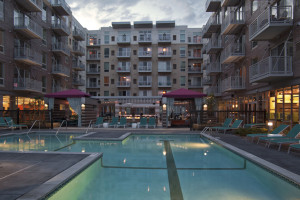
Welcome to the
Healy Project
Join us on Facebook
Send us an Email
Revoltin’ Developments III: Density and Livability
One of the boasts of contemporary urban planners is that high density brings to the city a variety of benefits, such as energy savings, public transportation, and a boost to the local economy and city tax coffers. The four-story Lander development that seeks to replace the two houses at 2316-2320 Colfax Avenue is a harbinger of higher density in the apex of the Wedge. This increased density will have a long-term impact on livablility in the neighborhood. While it is true that higher density can mean a more efficient use of resources, it can also bring social ills, such as the displacement of tenants of limited means and families with children, as well as the destruction of community identity.
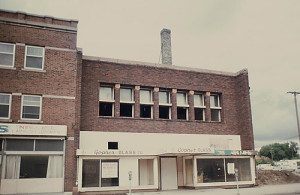 |
| The Hegg Building, Purcell and Elmslie, 1915, demolished for K-Mart, 1980. An example of thoughtless redevelopment. |
I have lived in Lowry Hill East since 1976. The ‘Seventies witnessed an ongoing struggle between Wedge residents trying to make this an attractive place to live and the forces of urban decay–prostitution, drugs, delinquency, and heavy commuter traffic. Most of the new homeowners were attracted to Wedge houses because: 1) real estate was relatively inexpensive, 2) the old houses had architectural charm, and 3) a lively, politically savvy community had taken root in the form of LHENA.
But even though LHENA accomplished much at City Hall (partial downzoning and traffic reduction for two), individuals as well had to step up and do battle. One example was on my block of Emerson Avenue. In the early 1980s, an old couple cashed out their duplex two doors down from my house to a slumlord. The duplex became a drug warehouse, with more than 20 unrelated people inhabiting the lower unit. Taxis and cars pulled up at all hours of the day and night, picking up packages. Drugged out tenants harassed all their neighbors with rude comments and raucous behavior. My next door neighbor at that time was an IRS agent, completely unfazed by having to work his way through multiple levels of government. It took a whole year, but one day Minneapolis SWAT turned up and hauled away the drug warehouse people in the duplex, and the slumlord became the target of an IRS audit.
 |
However, most of the battling was done by homeowners in the northern R-6 part of the Wedge, the higher density area. To protect themselves, their families, and property, homeowners monitored badly managed apartment buildings and rooming houses, calling in the police and City housing inspectors.. But often, City agencies weren’t able to stop the problem, forcing residents to act on their own. In one memorable case, a two-and-a-half story walkup on Bryant Avenue had become home to prostitutes who had frequent noisy nocturnal customers. One of these guys showed up like clockwork on weekends, creating a disturbance in the wee hours of the morning each time. After a number of strategies failed to stop him, one night the owner of the house across the street got in his car and followed the John to his home in Golden Valley. There the homeowner confronted him with the news that if he, the John, ever made a disturbance in the Wedge again, the homeowner would be coming out to tell his wife and children of his activities. The John was never seen again.
Through these and similar heroic efforts, the homeowners of the Wedge, along with their allies among renters and landlords, have made Lowry Hill East one of Minneapolis’s most desirable places to live and work. In so doing, they have made considerable investments of time and capital. However, with the proposed displacement of two houses by a new apartment complex, it seems that the neighborhood is becoming a victim of its own success. Lander has redeveloped the southern Greenway part of the Wedge into many apartment, townhouse, and condominium units. Now Lander, along with the City, is planning to start the redevelopment of the apex into another high density area. Have these homeowners fought this long battle to save the neighborhood and its houses, only to be exploited and ultimately driven out by the City?
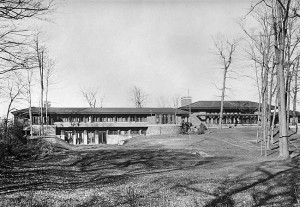 |
| The Francis W. Little House in Deephaven by Frank Lloyd Wright, 1912-1972. Demolition, like extinction, is forever. |
Sometimes it’s enlightening to see one’s neighborhood through the eyes of outside observers. On one dark November evening last year, I took a shuttle from the airport to my house. I was the only local resident aboard the shuttle; the other eight passengers were business people headed for downtown hotels. Despite my request to stop, the driver overshot my house by about a half block. As I tried to exit the van, the other passengers insisted that the driver back up to let me off directly in front of my house. Why? To them, the place looked very scary, and they were sure I’d be in danger out on the street. As I clambered from the back seat to the door, I tried to assure them that I would not be mugged on my way to the corner. But it was no use. People see things through the filters of their preconceived notions and experience. To them, this was the old inner city, alien and terrifying. I’m sure some of them would have been all for razing the entire neighborhood and building shiny new glass, brick and metal condos and apartments in its place.
This kind of skewered view of the neighborhood is one of the reasons that I am not impressed by the arguments for higher density by those who live in low-density neighborhoods of the city. As one who has lived in the Wedge for 36 years, I’ve seen the attempts to remove “urban blight” first through the building of small walkup apartment buildings, and now, through the construction of apartments and condos for the affluent.
The Wedge already has its fair share of high density housing in the Lander Greenway developments and the apartment buildings on and near Hennepin and Lyndale Avenues. Those who want higher density in the apex would be more convincing if they themselves lived in high density areas. Put your money–and home purchases–where your mouth is. Only those who have homes in high density areas can understand the day-to-day trials and challenges: the traffic snarls, snow emergency melees, street noise, loud parties, drunken revelers, etc. As density increases, such areas become less attractive to families, who understandably prefer to raise their children in neighborhoods of single-family homes.
As an election judge in 10-2, I got to see hundreds of my neighbors–people who stood in the cold and rain for an hour or more to exercise their right to vote. Young and old, gay and straight, professional and blue collar, handicapped and able, affluent and poor, married and single, native-born and naturalized, of all colors and races–they represent what makes the Wedge a great place to live.
I say again, if 2316 and 2320 are wrecked for the four-story Lander apartment building, it will be the harbinger of more of the same. Density doesn’t always mean diversity. Keep tearing down houses for condos and apartment buildings and inevitably some groups will start disappearing from the mix–families, old folks, people of modest means.
If the Lander project goes forward, it will send a clear signal to those who hope to redevelop Lowry Hill East into a high density Eden: Gentlemen, start your bulldozers.
Next: Theory and Practice in Urban Planning.
–T.B.
In 1980 when then-Wedge-resident Anders Christensen examined the building permits for all the houses in Lowry Hill East, he discovered that a master builder named Theron Potter Healy had built 30 of them. Further research revealed that during his career (1886-1906), Healy had built over 120 houses and commercial buildings in Minneapolis.
In 1993 Healy’s most celebrated creations, the Queen Annes of the 3100 block of Second and Third Avenue South, received national historic designation as the Healy Block Historic District. In 1977 Healy’s Bennett-McBride House had been listed on the National Register of Historic Places as a superb example of the Queen Anne architectural style.
During the first Wedge Zoning and Planning Committee meeting on the Lander Group’s redevelopment plans for 24th and Colfax, architect Pete Keeley said he had contacted the City, and they had said the two houses slated for demolition had “no historical significance.” At the second meeting, another man supporting owner Michael Crow alleged that the Minnesota Historical Society, too, had said that the Healy house at 2320 was not historically important. I’m sure that both claims are true: Neither the City nor M.H.S. have anything on record about either house.
None of Healy’s Wedge houses have received historic designation, but that does not mean that they are not historic or architecturally significant. Many historic buildings have not received official historic designation (through the Historic Preservation Commission or the National Trust, for example), but that in itself does not speak to their importance.
Consider, for example, the Wedge’s own “Healy Block”, the 2400 block of Bryant Avenue South. Eight (probably nine) houses on this block are Healy’s: 2401, -05, -09,(-10),-20, -24, -28, -36, and -39, ranging in style from Queen Anne to Colonial Revival.
 |
| 2439 Bryant, Colonial Revival, 1905 |
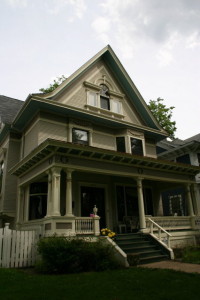 |
|||||||||||||
| 2409 Bryant, Queen Anne, 1895 |
On Bryant Avenue north of 24th Street (in the R-6 zone) are four other Healy houses; three of these are currently rooming houses. None of the houses on the 2400 block are rooming houses, although half of them were at one time. Former residents have told stories of tenants riding motorcycles up staircases, drunken brawls, drug deals, even murders taking place in these houses. Yet today, with the investments in time and money of their owner-occupants, they have become beautiful and valuable homes.
2320 Colfax, the Healy house slated for demolition, represents a pivotal point in Healy’s career. It is one of only two houses built by Healy in 1893. The other 1893 Healy house, 821 Douglas Avenue, was wrecked in 1981 by developer Paul Klodt. 1893 is a significant year in the history of architecture, the year of the Chicago World’s Fair. In this year the Queen Anne style began to fall out of fashion, replaced by the Colonial Revival style, made popular by the Fair’s “White City”. 2320 is Healy’s first Colonial Revival house, a significant part of his architectural legacy.
An old photo of 2320 reveals the original appearance of the house, with a large barn in back, and open field to the north:
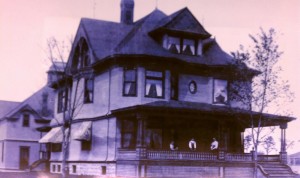 |
| The Orth House, 2320 Colfax, as it appeared when new. |
 |
| The house today. The porch has been enclosed, but the original roof line, profile, and fenestration remain. |
Obviously, some people don’t care diddlysquat about history or architecture, and this blog is not addressed to them. I have learned a very important lesson from my service on the Minneapolis Heritage Preservation Commission and the Advocacy Committee of the Preservation Alliance of Minnesota: Governments and institutions are not concerned with saving buildings. Communities must define and speak out on what’s important to the community–and work to preserve it.
The 2004 LHENA Zoning Task Force clearly articulated what is important to Wedge residents, that is, ensuring the livability of the neighborhood by preserving the current mix of houses and multiple-unit buildings. Michael Lander has already redeveloped the southern part of the Wedge along the Greenway with high density apartment buildings and condominiums. This redevelopment makes sense in that it replaced a defunct industrial area. But the apex of the Wedge is a different story. Development supporters have made much of the idea of saving the neighborhood “core”, while keeping the “fringe” high density. Truth to say, the apex is such a small area that most of it can be considered “fringe” of the greater neighborhood, the current view from City Hall. The point is moot: R-6 allows high density throughout, so-called “core” included.
Last month a first in a series of meetings was convened by the City to look into the feasibility of establishing “conservation districts” in Minneapolis. Such districts would offer more protections than the zoning code, but fewer than those of historic districts, such as the Healy Block. A conservation district would certainly be a big step forward in saving the houses in the apex of the Wedge, but the idea is only at the beginning of a long planning process, with no guarantee it will be adopted.
 |
| “360 Degrees of Wedge Healys”–Photo art by Richard Mueller |
In conclusion, I want to stress that if you want to save 2320 Colfax and preserve the other houses in the Wedge, don’t expect City Hall or an historical society to do it for you. Property rights are held sacrosanct in this country, and owners can wreck properties on the National Register if they so choose. Case in point–the developer in Arizona who wants to demolish a house designed by Frank Lloyd Wright. Despite a firestorm of outrage and temporary stay of demolition from the City of Phoenix, the developer is still determined to take it down.
Former Zoning Task Force member Sue Bode said at the first LHENA hearing about the 2316-2320 plan, “Taking down a Healy house is like destroying one by Frank Lloyd Wright.” If you care about Healy’s legacy, if you care about the old houses of the Wedge, speak out.
 |
|
| CAN PREVENT DEMOLITIONS! |
–T.B.
